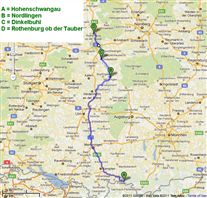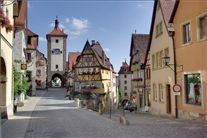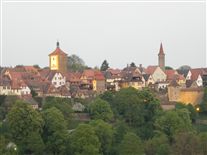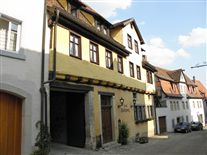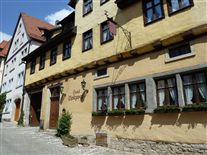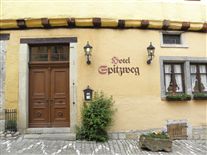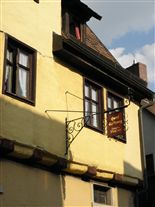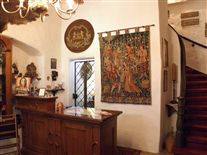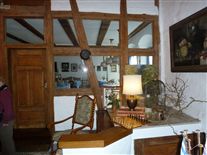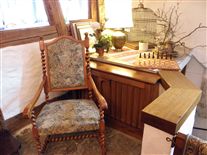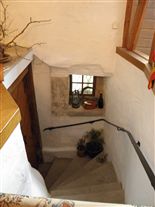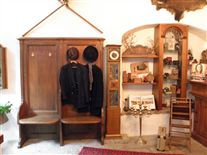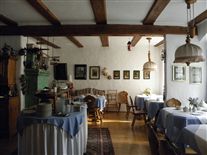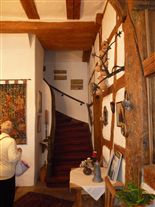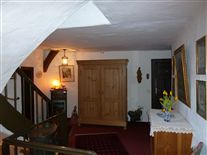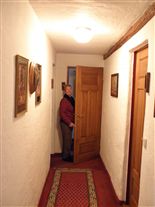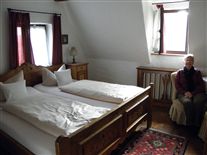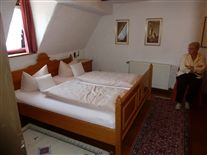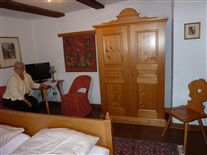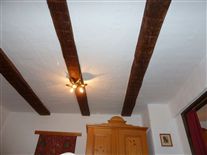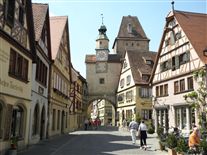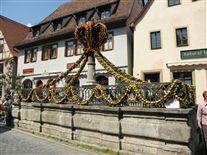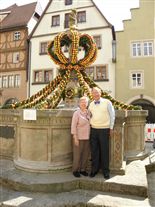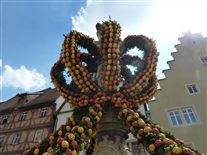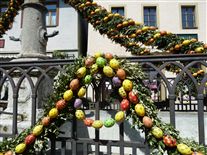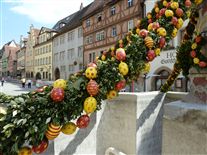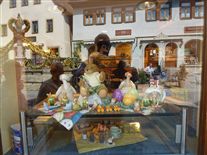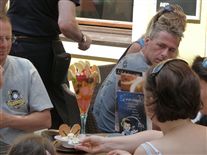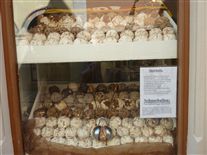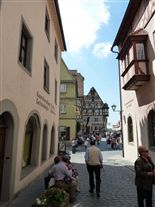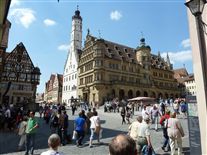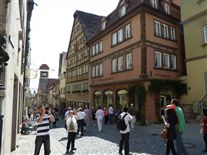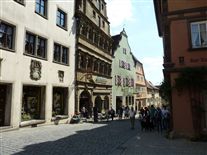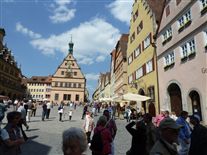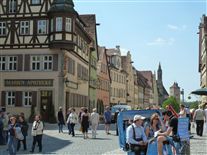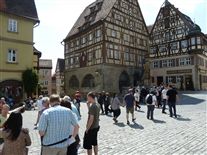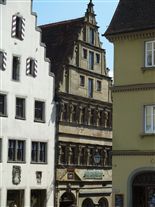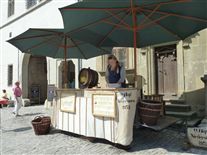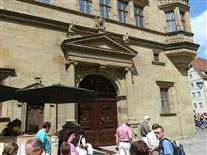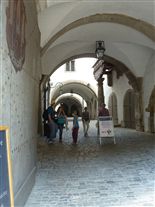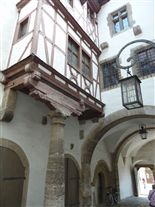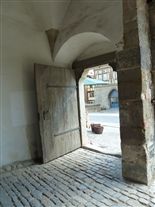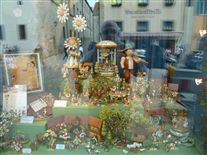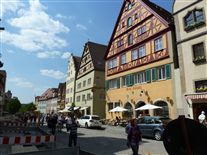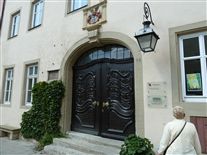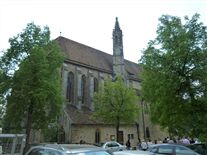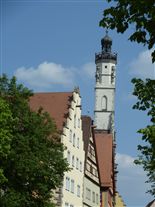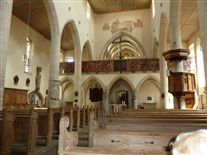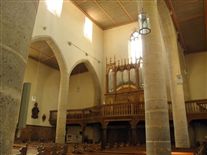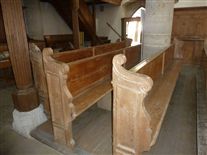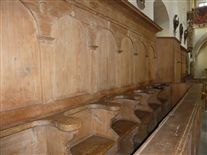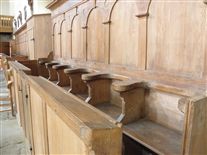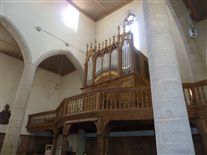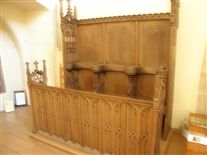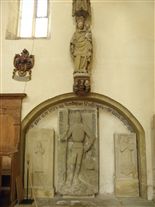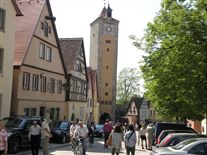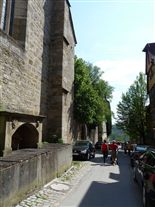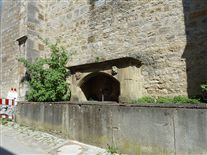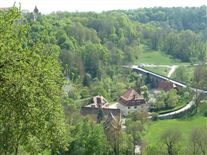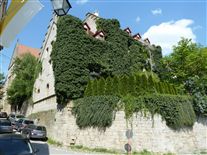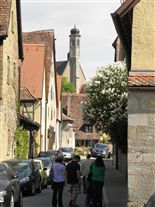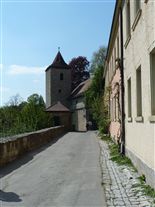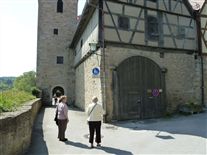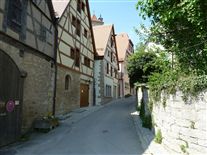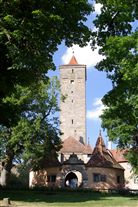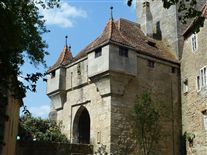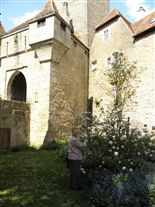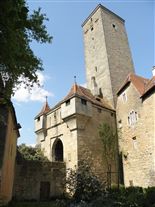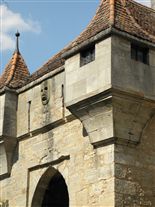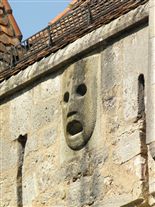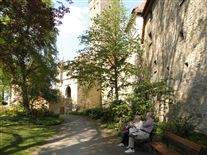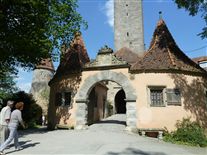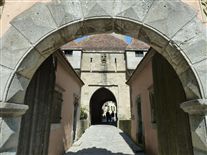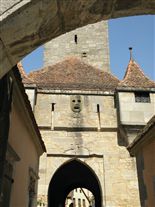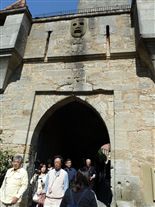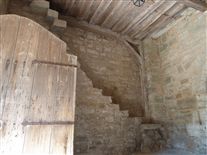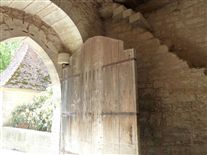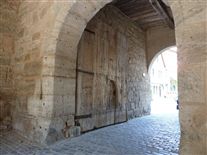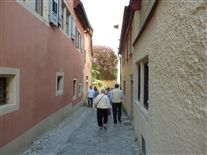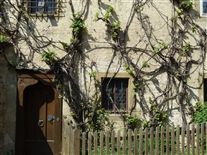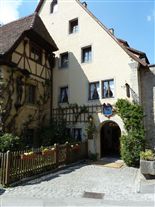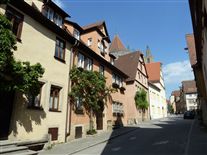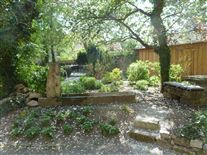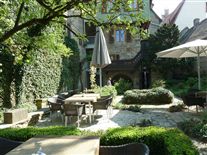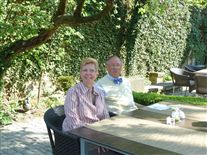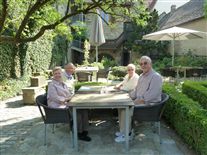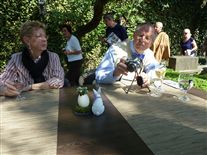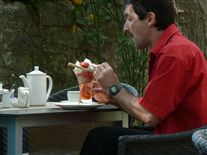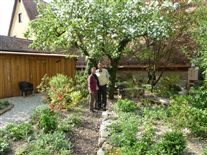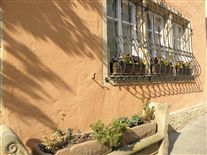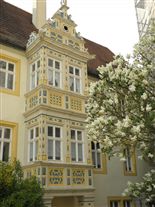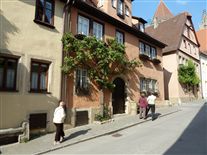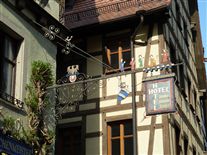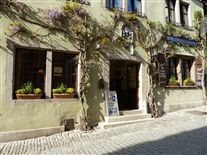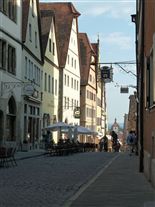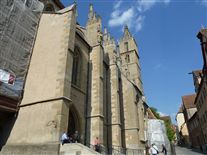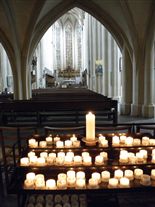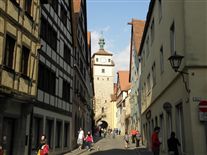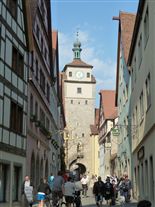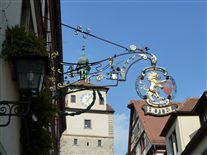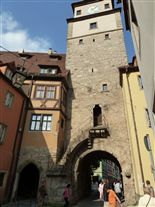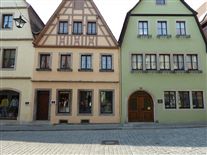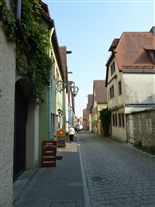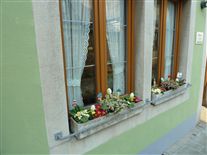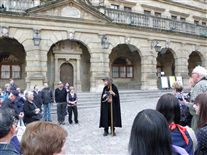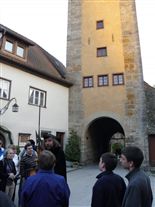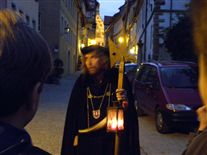Rothenburg_BW_4.jpg
Rorhenburg ob der Tauber - Click 'Details' for more information
Rothenburg ob der Tauber (German pronunciation: [ˈʁoːtənbʊɐ̯k ɔp deːɐ̯ ˈtaʊbɐ]) is a town in the district of Ansbach of Mittelfranken (Middle Franconia), the Franconia region of Bavaria, Germany, well known for its well-preserved medieval old town, a destination for tourists from around the world. In the Middle Ages, it was an Imperial Free City. Traffic-reducing measures are in place in a significant portion of Rothenburg.
The name "Rothenburg ob der Tauber" means, in German, "Red fortress above the Tauber". This is so because the town is located on a plateau overlooking the Tauber river. As to the name "Rothenburg", some say it comes from the German words Rot (Red) and Burg (burgh, medieval fortified town), referring to the red colour of the roofs of the houses which overlook the river. The name may also refer to the process of retting ("rotten" in German) flax for linen production.
History:
In 950 the weir system in today’s castle garden was constructed by the Count of Comburg-Rothenburg.
In 1070, The Counts of Comburg-Rothenburg, who also owned the village “Gebsattel”, built Rothenburg castle on the mountain top high above the river Tauber.
The Counts of the Comburg-Rothenburg dynasty died out in 1116. The last Count, Count Heinrich, willed all his belongings, including Gebsattel and Rothenburg, to the Comburg convent, but Emperor Heinrich V appointed instead his nephew Konrad von Hohenstaufen as successor to the Comburg-Rothenburg properties.
In 1142, Konrad von Hohenstaufen, who became Konrad III (1138–52) the Roman-German King, traded a part of the monastery Neumünster in Würzburg above the village Detwang and built the Stauffer-Castle Rothenburg on this cheaper land. He held court there and appointed reeves as caretaker.
In 1170 the city of Rothenburg was founded at the time of the building of Staufer castle. The centre was the market place and St. James' Church (in German: the St. Jakob). The development of the oldest fortification can be seen: the old cellar / old moat and the milk market. Walls and towers were built in the 13th century. Preserved are the “White Tower” and the Markus Tower with the Röder Arch.
From 1194 to 1254, the representatives of the Staufer dynasty governed the area around Rothenburg. Around this time the Order of St. John and other orders were founded near St. James' Church and a Dominican nunnery (1258)
From 1241 to 1242, The Staufer Imperial tax statistics recorded the names of the Jews in Rothenburg. Rabbi Meir Ben Baruch of Rothenburg (died 1293, buried 1307 in Worms) had a great reputation as a jurist in Europe. His descendants include members of the dynastic family von Rothberg, noteworthy in that they were accorded noble status in the nineteenth century, becoming the hereditary Counts of Rothberg, later taking up residence in the city of Berlin where they were well known as jewelers until the 1930s. Most members of the family disappeared and are presumed to have been killed during the Second World War. Several of the von Rothbergs were laid to rest in a crypt located in the Weißensee Cemetery, while two members immigrated to the United States during the Second World War. The family is survived by its last living descendant, Andrew Sandilands Graf von Rothberg (b. 1972), who resides in the United States.
In 1274 Rothenburg was accorded privileges by King Rudolf of Habsburg as an imperial city. Three famous fairs were established in the city and in the following centuries the city expanded. The citizens of the city and the Knights of the Hinterland build the Franziskaner (Franciscan) Monastery and the Holy Ghost Hospital (1376/78 incorporated into the city walls). The German Order began the building of St. James' Church, which the citizens have used since 1336. The Heilig Blut (Holy Blood) pilgrimage attracted many pilgrims to Rothenburg, at the time one of the 20 largest cities of the Holy Roman Empire. The population was around 5,500 people within the city walls and another 14,000 in the 150 square miles (390 km2) of surrounding territory.
The Staufer castle was destroyed by an earthquake in 1356, the St. Blaise chapel is the last remnant today.
In October 1631, during the Thirty Years' War, the Catholic Johann Tserclaes, Count of Tilly, wanted to quarter his 40,000 troops in Protestant Lutheran Rothenburg. Rather than allow entrance, the town defended itself and intended to withstand a siege. However, Tilly's troops quickly defeated Rothenburg, losing only 300 soldiers. After the winter they left the town poor and nearly empty, and in 1634 the Black Death killed many more. Without any money or power, Rothenburg stopped growing thus preserving its 17th century state.
Since 1803 the town has been a part of Bavaria. Romanticism artists (e.g. Carl Spitzweg) of the 1880s rediscovered Rothenburg, bringing tourism to the town. Laws were created to prevent major changes to the town.
Rothenburg held a special significance for Nazi ideologists. For them, it was the epitome of the German 'Home Town', representing all that was quintessentially German. Throughout the 1930s the Nazi organisation "KDF" ("Kraft durch Freude") Strength through Joy organized regular day trips to Rothenburg from all across the Reich. This initiative was staunchly supported by Rothenburg's citizenry – many of whom were sympathetic to National Socialism – both for its economic benefits and because Rothenburg was hailed as "the most German of German towns". In October 1938 Rothenburg expelled its Jewish citizens, much to the approval of Nazis and their supporters across Germany.[2]
In March 1945 in World War II, German soldiers were stationed in Rothenburg to defend it. On March 31, bombs were dropped over Rothenburg by 16 planes, killing 39 people and destroying 306 houses, six public buildings, nine watchtowers, and over 2,000 feet (610 m) of the wall. The U.S Assistant Secretary of War John J. McCloy knew about the historic importance and beauty of Rothenburg, so he ordered US Army General Jacob L. Devers not use artillery in taking Rothenburg. The local military commander Major Thömmes ignored the order of Adolf Hitler for all towns to fight to the end and gave up the town, thereby saving it from total destruction by artillery. American troops of the 12th Infantry Regiment, 4th Division occupied the town on April 17, 1945, and in November 1948 McCloy was named Honorable Protectorate of Rothenburg. After the war, the residents of the city quickly repaired the bombing damage. Donations for the rebuilding were received from all over the world. The rebuilt walls feature commemorative bricks with donor names.
Town:
To the left of the picture forming the west side of the town hall square is the Rathaus or town hall. The rear Gothic part of the building dates from 1250, and the attached front Renaissance building was started in 1572. This building served as the seat of government for the city-state during the medieval ages and for the city of Rothenburg since the formation of the federalist government. The town hall tower of Rothenburg ob der Tauber is one of the Roedertor tower at the east end of the city, and is open daily for visitors to climb. It is almost 61 meters high (200 ft). At the top of the tower, an entry fee of 5 euros is charged to allow entry into a room from where scenic views of almost the whole town are available. The room also contains manuscripts providing the visitor with historical information regarding the construction and relevant history of the city wall.
Rothenburg city as seen from the top of the town hall towerWhile buildings within the walled city reflect the city's medieval history, this part of the city is in many ways a normal, modern German town with some concession to the tourist trade. Many stores and hotels that are centered on tourists are clustered around the Town Hall Square and along several major thoroughfares (Herrngasse, Schmiedgasse). Also in the town is a criminal museum, containing various punishment and torture devices as used during the Middle Ages. For authentic Rothenburg ob der Tauber fare, one should have schneeballen, which are egg dough fried and then either sprinkled with powdered sugar or covered with chocolate.
The mayor of Rothenburg was Herbert Hachtel (SPD) from 1988 until March 2006, he was followed by Walter Hartl.
